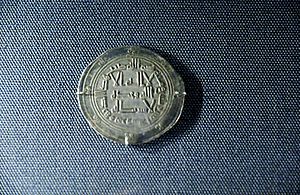Abu Muslim facts for kids
Quick facts for kids
Abu Muslim
|
|
|---|---|
| Persian: ابو مسلم خراسانی | |

"Abu Muslim chastises a man for telling tales," Folio from the Ethics of Nasir (Akhlaq-e Nasiri) by Nasir al-Din Tusi. Copy created in Lahore between 1590–1595
|
|
| Born |
Unknown birth name, possibly Behzadan, or Ibrahim
718/19 or 723/27 |
| Died | 755 Al-Mada'in, Iraq
|
| Known for | Abbasid Revolution |
| Title | Abbasid governor of Khurasan |
| Term | 748–755 |
| Predecessor | Nasr ibn Sayyar (as Umayyad governor) |
Abu Muslim Abd al-Rahman ibn Muslim al-Khurasani was a very important Persian general. He lived from about 718 or 723 to 755. Abu Muslim led a big movement called the Abbasid Revolution. This revolution helped to overthrow the Umayyad dynasty and bring the Abbasid dynasty to power.
Contents
Who Was Abu Muslim?
Sources tell different stories about Abu Muslim's original name and where he came from. Some say his first name was Behzadan, son of Vendad Hormoz. Others suggest he was related to the Abbasid family.
Most historians agree he was likely of Persian origin. He was born either in Merv or near Isfahan. The exact year he was born is not fully known, but it was either around 718 or between 723 and 727.
Early Life and Activism
Abu Muslim grew up in a city called Kufa. There, he worked as a slave and a saddler. In Kufa, he met Shia Muslims.
At that time, Kufa was full of people unhappy with the ruling Umayyad dynasty. The Umayyads often treated non-Arab Muslims (called mawālī) unfairly. This went against the idea of equality in Islam. Many people also disliked the luxurious lives of the Umayyad rulers. They wanted a leader from the family of Muhammad who would rule fairly.
By 737, Abu Muslim was part of a group led by al-Mughira ibn Sa'id. These activities led to him being put in prison. In 741 or 742, he was freed by important Abbasid leaders. They were on their way to Mecca.
He was then introduced to Ibrahim ibn Muhammad, the head of the Abbasid family. In 745 or 746, Ibrahim sent Abu Muslim to lead the Abbasid movement in Khurasan.
Leading the Abbasid Revolution

Khurasan was a good place for the Abbasids to gain support. It was far from the Umayyad capital in Syria. Many Arab settlers and local converts lived there. They often worked together and disliked the Umayyad rulers.
When Abu Muslim arrived in Khurasan, the area was in chaos. There was a civil war among the Umayyads. This caused fights between different tribal groups. The governor, Nasr ibn Sayyar, was driven out of Merv in 746.
Abu Muslim took control of Merv in December 747 or January 748. He defeated the Umayyad governor and another leader. He became the real ruler of Khurasan. He also became famous as a general. He put down a rebellion led by Bihafarid, who followed a different Persian religion. Abu Muslim got help from both Muslims and Zoroastrians to stop this rebellion.
In 750, Abu Muslim led the Abbasid army. They defeated the Umayyads in the important Battle of the Zab. This battle was a major step in overthrowing the Umayyad dynasty.
Abu Muslim's Rule and Death
After the Abbasid family took power, Abu Muslim stayed as governor of Khurasan. He stopped a Shia uprising in Bukhara in 750 or 751. He also helped the Muslims expand their control into Central Asia.
People really liked Abu Muslim because he was a hero in the revolution. He was also good at bringing different groups together. This included Shia Muslims, Sunnis, Zoroastrians, Jews, and Christians.
The first Abbasid caliph, al-Saffah, generally trusted Abu Muslim. However, he was careful about Abu Muslim's growing power. Al-Saffah's brother, al-Mansur, often told him to have Abu Muslim killed. Al-Mansur was worried about Abu Muslim's influence.
When al-Mansur became the new caliph, his uncle rebelled. Al-Mansur asked Abu Muslim to stop this rebellion, which he did. But relations between Abu Muslim and al-Mansur got worse. Al-Mansur tried to reduce Abu Muslim's power.
Abu Muslim was worried that al-Mansur would kill him if he met the caliph. But he eventually decided to go. He met al-Mansur in al-Mada'in in 755. Al-Mansur listed his complaints against Abu Muslim. Abu Muslim reminded the caliph of all he had done to help him become ruler. Al-Mansur then ordered his guards to kill Abu Muslim.
Legacy
Many people in Khurasan were very upset about Abu Muslim's death. There were feelings of anger and rebellion against al-Mansur. Abu Muslim became a legendary figure in Persia.
Several people started revolts, claiming that Abu Muslim had not died and would return. These included his own supporter Ishaq al-Turk and the Zoroastrian cleric Sunpadh. Even Babak, another famous rebel, claimed to be related to him.
There are many different stories and legends about Abu Muslim in Central Asia, Iran, and Afghanistan. Some local saints are even linked to him in these stories.
See also
 In Spanish: Abu Muslim para niños
In Spanish: Abu Muslim para niños
- Babak Khorramdin
- Sunpadh
- Behafarid

